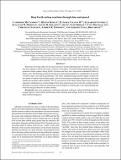Files in this item
Deep Earth carbon reactions through time and space
Item metadata
| dc.contributor.author | McCammon, Catherine | |
| dc.contributor.author | Bureau, Hélène | |
| dc.contributor.author | Cleaves II, H. James | |
| dc.contributor.author | Cottrell, Elizabeth | |
| dc.contributor.author | Dorfman, Susannah M. | |
| dc.contributor.author | Kellogg, Louise H | |
| dc.contributor.author | Li, Jie | |
| dc.contributor.author | Mikhail, Sami | |
| dc.contributor.author | Moussallam, Yves | |
| dc.contributor.author | Sanloup, Chrystele | |
| dc.contributor.author | Thomson, Andrew R | |
| dc.contributor.author | Brovarone, Alberto Vitale | |
| dc.date.accessioned | 2020-01-06T12:30:08Z | |
| dc.date.available | 2020-01-06T12:30:08Z | |
| dc.date.issued | 2020-01-02 | |
| dc.identifier | 261244649 | |
| dc.identifier | 94239993-7c57-41f6-8c3d-7283efe6ed4a | |
| dc.identifier | 85078556531 | |
| dc.identifier | 000505007500003 | |
| dc.identifier.citation | McCammon , C , Bureau , H , Cleaves II , H J , Cottrell , E , Dorfman , S M , Kellogg , L H , Li , J , Mikhail , S , Moussallam , Y , Sanloup , C , Thomson , A R & Brovarone , A V 2020 , ' Deep Earth carbon reactions through time and space ' , American Mineralogist , vol. 105 , no. 1 , pp. 22-27 . https://doi.org/10.2138/am-2020-6888CCBY | en |
| dc.identifier.issn | 0003-004X | |
| dc.identifier.other | ORCID: /0000-0001-5276-0229/work/67167751 | |
| dc.identifier.uri | https://hdl.handle.net/10023/19223 | |
| dc.description | The authors acknowledge partial support from the Sloan Foundation grant G-2016-7157. | en |
| dc.description.abstract | Reactions involving carbon in the deep Earth have limited manifestation on Earth’s surface, yet they have played a critical role in the evolution of our planet. The metal-silicate partitioning reaction promoted carbon capture during Earth’s accretion and may have sequestered substantial carbon in Earth’s core. The freezing reaction involving iron-carbon liquid could have contributed to the growth of Earth’s inner core and the geodynamo. The redox melting/freezing reaction largely controls the movement of carbon in the modern mantle, and reactions between carbonates and silicates in the deep mantle also promote carbon mobility. The ten-year activity of the Deep Carbon Observatory has made important contributions to our knowledge of how these reactions are involved in the cycling of carbon throughout our planet, both past and present, and helped to identify gaps in our understanding that motivate and give direction to future studies. | |
| dc.format.extent | 6 | |
| dc.format.extent | 404608 | |
| dc.language.iso | eng | |
| dc.relation.ispartof | American Mineralogist | en |
| dc.subject | Inner core | en |
| dc.subject | Geodynamo | en |
| dc.subject | Subduction | en |
| dc.subject | Diamond | en |
| dc.subject | Carbonate | en |
| dc.subject | Carbon-rich fluids and melts | en |
| dc.subject | Oxygen fugacity | en |
| dc.subject | Metal-silicate partitioning | en |
| dc.subject | Redox freezing and melting | en |
| dc.subject | GE Environmental Sciences | en |
| dc.subject.lcc | GE | en |
| dc.title | Deep Earth carbon reactions through time and space | en |
| dc.type | Journal item | en |
| dc.contributor.institution | University of St Andrews. School of Earth & Environmental Sciences | en |
| dc.contributor.institution | University of St Andrews. St Andrews Centre for Exoplanet Science | en |
| dc.contributor.institution | University of St Andrews. St Andrews Isotope Geochemistry | en |
| dc.identifier.doi | https://doi.org/10.2138/am-2020-6888CCBY | |
| dc.description.status | Peer reviewed | en |
This item appears in the following Collection(s)
Items in the St Andrews Research Repository are protected by copyright, with all rights reserved, unless otherwise indicated.

